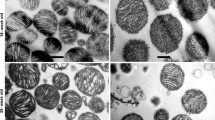Abstract
Background: We previously showed that mitochondrial respiratory function is abnormal in dogs with chronic heart failure (HF). Mitochondrial permeability transition pores (MPTP) can affect mitochondrial inner membrane potential (Δ < eqid1 > m) and mitochondrial function in normal cardiomyocytes. The potential impact of MPTP on Δ < eqid2 > m and mitochondrial respiratory function in HF has not yet been determined. We tested the hypothesis that cyclosporine A, a potent blocker of the MPTP, can improve mitochondrial function in HF. Methods: Cardiomyocytes were isolated from the left ventricular myocardium of 7 dogs with HF produced by intracoronary microembolizations and from 7 normal dogs. Cardiomyocytes were treated for 24 hours with cyclosporine A. Δ < eqid3 > m, cytochrome c oxidase protein expression, mitochondrial cytochrome c oxidase-dependent respiration (CDOR) and ATP synthesis were measured. Results: Δ < eqid4 > m, protein expression of cytochrome c oxidase, CDOR and the rate of ATP synthesis were decreased in HF compared to normal controls. Inhibition of MPTP in failing cardiomyocytes with low dose of cyclosporine A (0.2 μM) increased Δ < eqid5 > m, preserved expression of cytochrome c oxidase, improved CDOR and the rate of ATP synthesis. Conclusion: MPTP opening contributes to the loss of mitochondrial function observed in the failing heart. Inhibition of MPTP opening represents a potential therapeutic target for the treatment of HF.
Similar content being viewed by others
References
Sharov VG, Goussev AV, Lesch M, Goldstein S. Sabbah HN. Abnormal mitochondrial function in myocardium of dogs with chronic heart failure. J Mol Cell Cardiol 1998;30: 1757–1762.
Sharov VG, Todor AV, Silverman N, Goldstein S. Sabbah HN. Abnormal mitochondrial respiration in failed human myocardium. J Mol Cell Cardiol 2000;32:2361–2367.
Narula J, Pandey P, Arbustini E, Haider N, Narula N, Kolodgie FD, Dal Bellob B, Semigran MJ, Bielsa-Masdeu A, Dec GW, Israels S, Ballester M, Virmani R, Saxena S, Kharbanda S. Apoptosis in heart failure: release of cytochrome c from mitochondria and activation of caspase-3 in human cardiomyopathy. Proc Natl Acad Sci 1999;96:8144–8149.
Richter C, Ghafourifar P. Ceramide induced cytochrome c release from isolated mitochondria. Biochem Soe Symp 1999;66:27–31.
Schild L., Gellerich FN. Effect of the extramitochiondrial adenine nucleotide pool size on oxidative phosphorylation in isolated rat liver mitochondria. European Journal of Biochemistry 1998;252:508–512.
Weiss JN, Korge P, Honda HM, Ping P. Role of the mitochondrial permeability transition in myocardial disease. Circ Res 2003;93:292–301.
Dunne MJ. Protein phosphorylation is required for diazoxide to open ATP-sensitive potassium channel in insulin (RINm5F) secreting cells. FEBS Letters 1989;250:262–266.
Ohnuma Y, Miura T, Miki T, Tanno M, Kuno A, Tsuchida A, Shimamoto K. Opening of mitochondrial K(ATP) channel occurs downstream of OKC-epsilon activation in the mechanism of preconditioning. Am. J Physiol 2002;283:H440–H447.
Dos Santos P, Kowaltowski AJ, Laclau MN, Seetharaman S, Paucek P, Boudina S, Thambo JB, Tariosse L, Garlid KD. Mechanisms by which opening the mitochondrial ATP-sensitive K(+) channel protects the ischemic heart. Am J Physiol 2002;283:H284–H295.
Pain T, Yang XM, Critz SD, Yue Y, Nakano A, Liu GS, Heusch G, Cohen MV, Downey JM. Opening of mitochondrial K(ATP) channels triggers the preconditioned state by generating free radicals. Circ Res 2000;87:460–466.
Dorman BH, Hebbar L, Hinton R, Roy R, Spinale FG. Preservation of myocyte contractile function after hypothermic cardioplegic arrest by activation of ATP-sensitive potassium channel. Circulation 1997;96:2376–2384.
Xu M, Wang Y, Ayub A, Ashraf M. Mitochondrial K(ATP) channel activation reduces anoxic injury by restoring mitochondrial membrane potential. Am J Physiol 2001;281: H1295–H1303.
Eells JT, Henry MM, Gross GJ, Baker JE. Increased mitochondrial K(ATP) channel activity during chronic myocardial hypoxia: is cardioprotection mediated by improved bioenergetics? Circ Res. 2000;87:915–921.
Sabbah HN, Stein PD, Kono T, Gheorghiade M, Levine TB, Jafri S, Hawkins ET, Goldstein S. A canine model of chronic heart failure produced by multiple sequential coronary microembolizations. Am J Physiol 1991;260:H1379–H1384.
Lue WM, Boyden PA. Abnormal electrical properties of myocytes from chronically infarcted canine heart. Alterations in Vmax and the transient outward current. Circulation 1992;85:1175–1188.
Sanchez H, Zoll J, Bigard X, Veksler V, Mettauer B, Lampert E, Lonsdorfer J, Ventura-Clapier R. Effect of cyclosporine A and its vehicle on cardiac and skeletal muscle mitochondria: relationship to efficacy of the respiratory chain. British J Pharmacol 2001;133:781–788.
Reers M, Smith TW, Chen LB. J-aggregate formation of a carbocyanine as a quantitative fluorescent indicator of membrane potential. Biochemistry 1991;30:4480–4486.
Lundin A, Anson J, Kau P. ATP axtractans neutralized by cyclodextrin. In: Bioluminescence and Chemiluminescence, Campbell AK, Kricka LJ, Stanley PE. (Eds.) (John Wiley & Sons, Chichester), pp. 399–402.
Bers G, Garfin D. Protein and nucleic-acid blotting and immunobiochemical detection. Biotechniques 1985;3:276–288.
Gellerich FN, Khuchua ZA, Kuznetsov AV. Influence of the mitochondrial outer membrane and the binding of creatine kinase to the mitochondrial inner membrane on the compartmentation of adenine nucleotides in the intermembrane space of rat heart mitochondria. Biochimica et Biophysica Acta 1993;1140:327–334.
Wallimann T, Wyss M, Brdiczka D, Nicolay K., Eppenberger HM. Intracellular compartmentation, structure and function of creatine kinase isoenzymes in tissues with high and fluctuating energy demands: the ‘phosphocreatine circuit’ for cellular energy homeostasis. Biochemical Journal 1992;281(Pt 1): 21–40.
Halestrap AP, Doran E, Gillespie JP, O'Toole A. Mitochondria and cell death. Biochemical Society of Transactions 2000;28:170–177.
Brustovetsky N, Jemmerson R, Dubinsky JM. Calcium-induced Cytochrome c release from rat brain mitochondria is altered by digitonin. Neuroscience Letters 2002;332:91–94.
Author information
Authors and Affiliations
Corresponding author
Additional information
This study was supported by a grant from the National Heart, Lung, and Blood Institute PO1 HL074237-01.
Rights and permissions
About this article
Cite this article
Sharov, V.G., Todor, A.V., Imai, M. et al. Inhibition of Mitochondrial Permeability Transition Pores by Cyclosporine A Improves Cytochrome c Oxidase Function and Increases Rate of ATP Synthesis in Failing Cardiomyocytes. Heart Fail Rev 10, 305–310 (2005). https://doi.org/10.1007/s10741-005-7545-1
Published:
Issue Date:
DOI: https://doi.org/10.1007/s10741-005-7545-1




